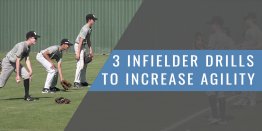| The 4 Fundamentals of Hitting a Baseball
By: Brian Smith Provided by: Stack.com
Your swing is something that needs to be worked on constantly so that it becomes muscle memory. After all, when the ball's on the way to the plate, you don't have time to think. You only have time to react. Here are four fundamentals that'll help you refine your swing and become a more consistent - and dangerous - hitter. Your feet, your hands and your head are keys to hitting success. If you can move them properly and in concert, you'll put yourself in great position to rack up hits. Feet The feet are the foundation for maintaining balance throughout your swing. Balance from the beginning through the finish of the swing is crucial for your ability to track the ball accurately. The stance should be comfortable. You should stand approximately a bat plus an arm's length away from the opposite side of the plate. To ensure you're in the right position, stand in the box and reach the bat to see if you can touch the opposite side of the plate. If you can, you'll be in a position that provides complete plate coverage. The load is when the hitter shifts all of his weight to his back foot while his entire body moves together. The load stops when the back knee and back shoulder are in line. The load is like the hammer on a revolver being cocked - it's done slowly and comes to a subtle stop before the trigger is pulled. It's the same thing in hitting: the load should happen in a slow and controlled manner before the swing is initiated. The stride happens next. The front foot strides in line with the back foot toward the pitcher. After a nice load and a soft stride, you should be in a balanced position and can begin to move your hands to the ball. We teach our hitters (regardless of age) to hit the ball where it's pitched and hit it into the outfield. That means that if the ball is on the outside part of the plate, you should try to take it to the opposite field. If it's on the inside part of the plate, you should try to pull the ball. Hands When moving your hands toward the ball, don't immediately extend your arms or push your hands forward. Keeping your hands back at the start of your swing will allow you to generate a lot of energy with your legs and core before bringing your hands through. As you make contact, your eyes should see the bat hit the ball. You should hit through the baseball, meaning your bat speed should be at its peak just before contact. This is a huge step in having a better hitting technique and driving the ball. Check out the video here to see how Kansas City Royals outfielder Alex Gordon focuses on keeping both hands on the bat to keep his upper body loose in batting practice. Head Your head should be still throughout the swing. An easy mental note to enforce keeping your head still is to think "Ike to Mike." This is a saying I learned from an older coach and it's a great way to teach hitters. "Ike" is on your front shoulder and "Mike" is on your back shoulder. You should say hello to "Ike" at the beginning of your swing and say hello to "Mike" after you hit the ball. In other words your chin should go from shoulder to shoulder while you swing the bat. You're not actually moving your chin, but your swing is rotating your shoulders. If you can control your head throughout the swing, hitting becomes easier. Hitting Drills to Build Fundamentals Building muscle memory for a fundamentally sound swing takes a ton of practice. The following drills can be done in order to gradually develop the proper muscle memory necessary to consistently drive the baseball. Dry Cut Drill Developing a hitting technique is as easy as counting to four - 1. load, 2. stride, 3. see the ball all the way, and 4. hit the ball. The Dry Cut Drill involves verbal commands from a coach, where he or she counts out loud 1, 2, 3 and 4. The key is to remain balanced throughout all of the steps.
The coach should have the hitter perform this simple drill on air before adding a ball. The hitter should learn how to swing and understand the checkpoints in this drill, which will enable him to make pitch-by-pitch adjustments in a game scenario. Tee Drill The Tee Drill helps you learn where to hit the ball. I heard Ken Griffey, Jr. say, "it's like jousting. If the pitcher throws the ball away, hit it to opposite field, and if he throws it inside, pull it." That's a very simple way to say it, but it means take your bat head to the ball and hit the ball where it's pitched. The contact point will determine where the ball travels. The outside pitch should be hit to the opposite field gap, middle pitch over the center fielder's head, and inside pitch should be smoked down the pull side foul line. The coach should move the tee all over the plate so the hitter has to adjust his swing to ensure the flight of the ball is toward the proper field. Flip Drill The Flip Drill is the next step in our fundamental hitting drills. The flipper moves according to the location the hitter is working. For an inside pitch, the ball should be tossed at the hitter's front hip, allowing him to work on pulling the ball. For a middle pitch, the ball should be tossed from a 45-degree angle in front of the hitter. The ball should head toward the hitter's belt buckle, forcing the hitter to get his hands through a middle pitch and hit a line drive up the middle. For an outside pitch, the flipper will be behind the hitter and the ball will travel through the contact zone on a line. This will encourage the hitter to focus on the ball all the way from the hand and to work on bat speed to drive the ball to the opposite field gap. Batting Practice Batting Practice is the next drill we use with our hitters. We throw from behind a screen to different locations to allow the hitter to work on taking the ball to all fields as well as the complete swing (remember 1-2-3-4.) The coach can count out loud to get the hitter in a rhythm and allow him to take that approach to a game scenario. Live At-Bats The final step is live at-bats from a pitcher or machine. We use a live pitcher when possible. This drill requires the hitter to put it all together. If the hitter has a flaw, it will be quite evident during this drill. When the ball travels at game speed, the hitter must stay controlled on steps 1, 2 and 3 and explode through step 4.
|






